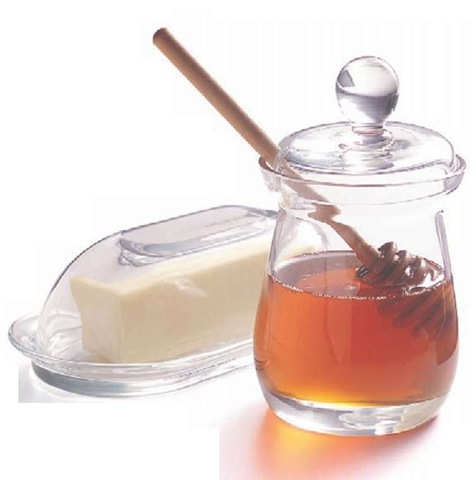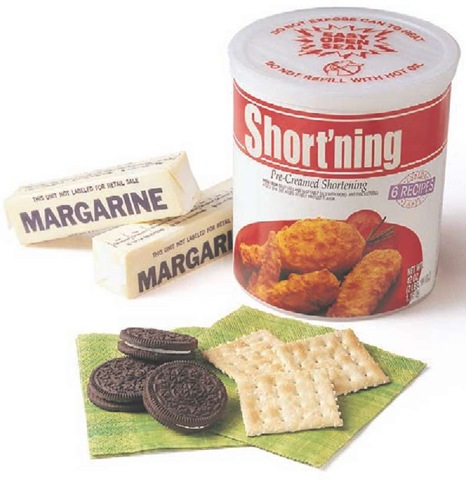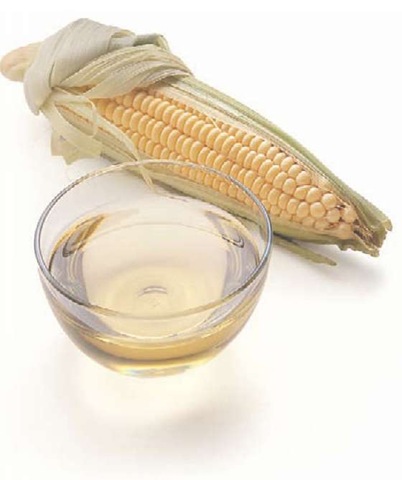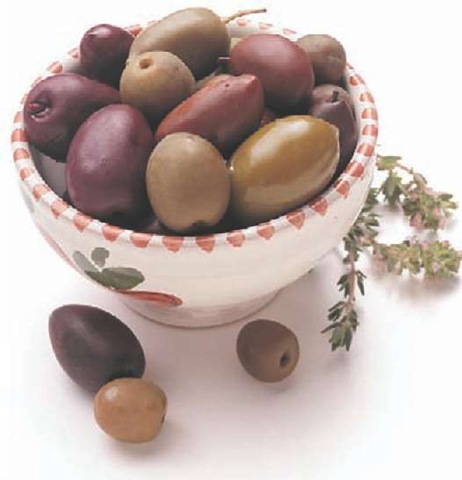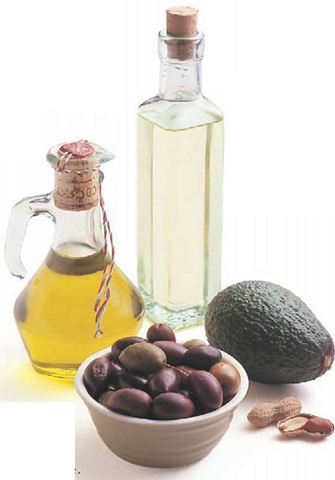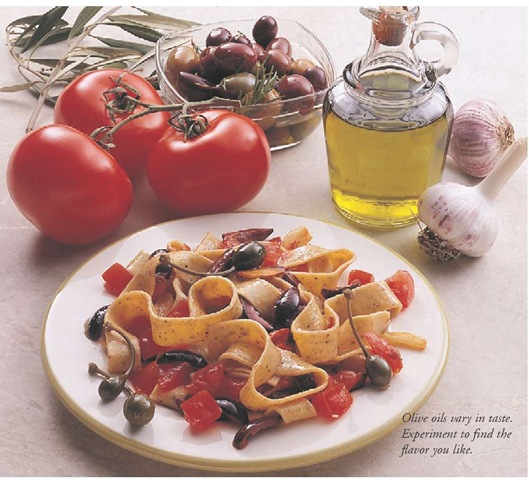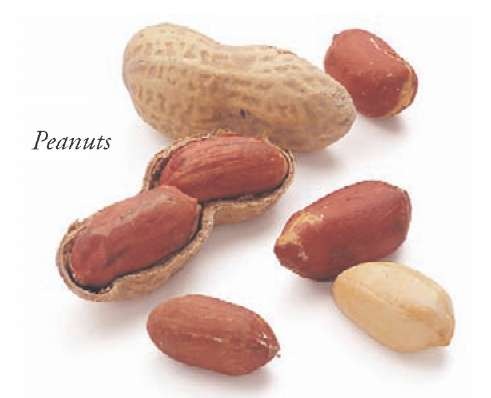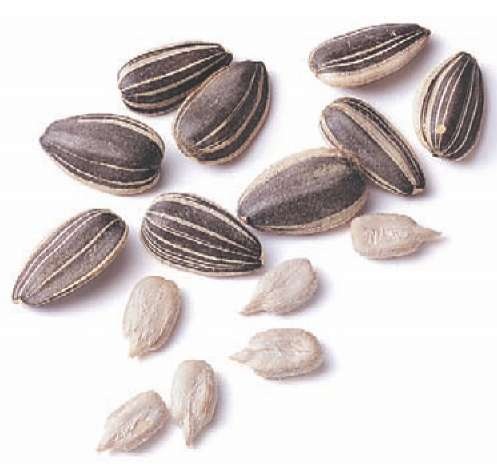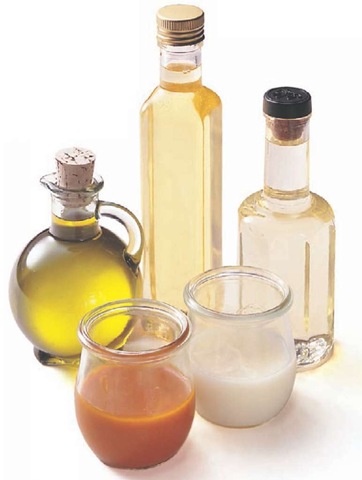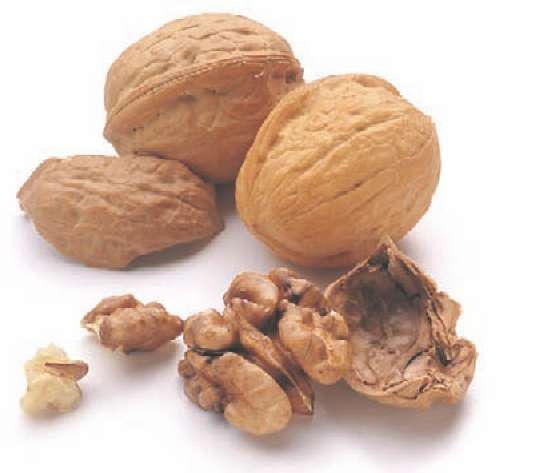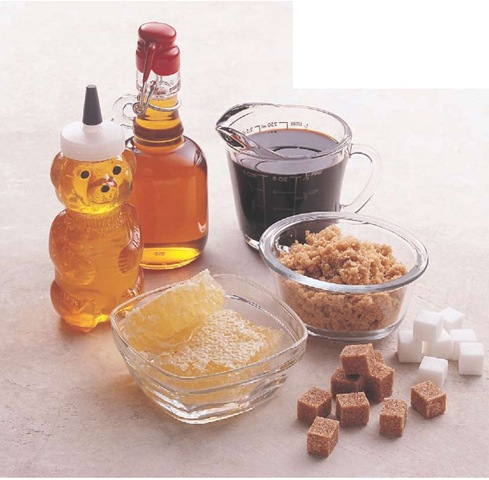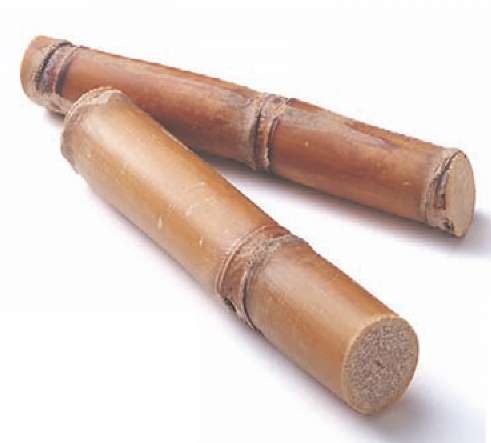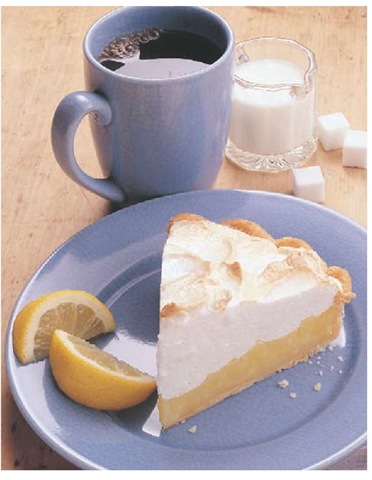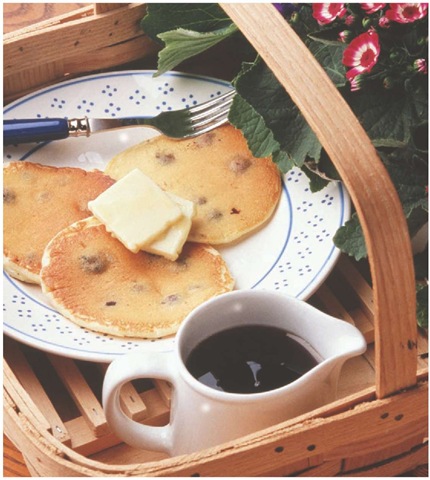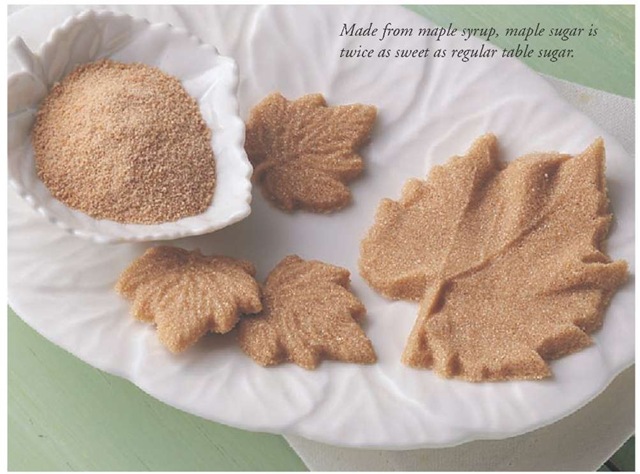If there is any food group that we have a love-hate relationship with, it’s fats, oils, and sweeteners.
On the one hand, these foods play a vital role in our enjoyment of what we eat. Fats and oils give a creaminess, richness, crispiness, or pleasing mouth-feel to foods. Sweeteners also satisfy a universal and natural craving. On the other hand, the pleasure that fats, oils, and sweeteners bring can come at a cost. These foods generally are high in calories, making it difficult for someone who eats a lot of them to maintain a healthful weight. They also have other health disadvantages. Too much of the wrong kinds of fats and oils can increase the blood cholesterol level, which in turn can increase risk for cardiovascular disease. Sugar and highly sweetened foods also are typically high in calories and provide few nutrients. For that reason, "empty calories" is a term often used to describe sweeteners or foods rich in them. Sugar and tooth decay are linked when sugar is eaten in excess and dental hygiene is poor.
The Food Guide Pyramid recognizes both the advantages and the disadvantages of these foods. It does not eliminate them. But it does place them at the very tip of the pyramid. It’s okay to use these foods as long as they are eaten sparingly. Making sure fats, oils, and sweeteners play the proper role in your diet involves knowing more about them, their role in the diet, and what foods are rich in them. To help you do this, this topic provides more detailed information on the types of fats, oils, and sweeteners you are likely to consume.
FATS & OILS
Basics
Fats, no matter what their source, play an important role in the food we eat. For centuries, every culture has taken advantage of the unique chemical properties of fats — for example, fats easily absorb other flavors. Fats also are used to cook foods, add a pleasing texture, impart tenderness to baked goods, and, in societies where food is scarce, increase the calorie content of a food. Fats, therefore, are a basic ingredient in cooking.
The term "fats," however, is broad, encompassing many different substances — from butter to lard to vegetable oil. All oils, for example, are fats. But not all fats are oils. Although definitions vary, for cooking purposes fats are generally characterized as follows:
Fats — Generally defined as substances that are solid at room temperature, fats include butter, cocoa butter, lard, margarine, suet, and vegetable shortening.
Oils — Oils remain liquid at room temperature. Oils can be made from various plants and seeds: vegetables, olives, rapeseed (from which canola oil is made), sunflower seeds, corn, peanuts, soybeans, walnuts, almonds, hazelnuts, safflower seeds, grape-seed, sesame seed, mustard seed, and coconuts are among the most commonly used.
No matter what form they take, fats are made up of fatty acids, which are themolecular building blocks of fats in the same way that amino acids combine to form protein. At their most basic, fatty acids are molecular chains of hydrogen, carbon, and oxygen atoms. The differences in the chemical structure of fats make some better for you than others.
Sometimes a process called hydrogena-tion is used to make liquid oils solid at room temperature. This also converts unsatu-rated fat into trans fat. Trans fats are used in many processed and fast foods, such as doughnuts, crackers, chips, and french fries. Trans fats also give margarine its butter-like consistency. Trans fats tend to increase your cholesterol level and therefore should be eaten in only limited amounts.
Nutrition
Fat is an essential nutrient. Our bodies require small amounts of several fatty acids to build cell membranes and to support life-sustaining functions. That said, the old adage about "too much of a good thing" is appropriate in discussing fat. Virtually all health experts agree that fat intake should be limited. The federal government, the American Heart Association, and other organizations recommend that fat intake for a healthy individual should be less than 30 percent of total daily calories. They also recommend that less than 8 to 10 percent of total calories come from saturated fat.
Although various kinds of fat have different effects on your blood cholesterol, all foods that are high in fat are high in calories. High-fat foods can easily increase your calories, making it difficult to maintain a healthful weight. Fat packs more calorie punch than any other type of nutrient group. Per gram, fat has 9 calories (about 100 calories per tablespoon, or 250 calories per ounce). In contrast, protein and carbohydrates have just 4 calories per gram. Because of this, you do not need to eat very much fat before reaching the 30 percent threshold.
If a low-fat diet is good, is an even lower-fat diet better? Not necessarily. Upper limits of fat intake have been established, but the same is not true for lower limits. Talk with your health care provider about the recommended fat intake that is best for you. Even a low-fat diet can lead to weight gain if you cut back on fat but take in excess calories by ignoring the rest of what you eat. Too many calories from any source result in added pounds. And ifthey add up to obesity, you are at increased risk for health problems.
Selection
Be discriminating in the type of fat you consume. Limit animal fat (saturated) and trans fats (hydrogenated oils). Instead, use small, sensible amounts of plant-based (monoun-saturated and polyunsaturated) fats.
When purchasing products, always check the expiration dates. Rancidity is a concern with any type of fat.
Purchasing oils, of which there are dozens of varieties, involves a close reading of the package label. Most cooks prefer to buy "cold pressed" oils, which means that minimal heat and pressure are used to extract the oil from the original plant or seed. This type of processing is considered important because it allows oil to maintain more of the plant’s natural flavors and textures. With the exception of extra-virgin olive oil, however, it is difficult to find cold-pressed oils.
A good alternative is to use so-called unrefined oils. Unrefined oils are extracted with heat. Unlike other oils, unrefined oils undergo minimal processing after this point. The result is a more flavorful oil and, sometimes, a more darkly colored oil. Unrefined oils generally include virgin olive oil and corn, nut, soybean, canola, and sesame oils. Unrefined oils break down easily under heat and thus should not be used for deep-frying. Because deep-fried foods are not typically part of a healthful diet, you should not have to trade a flavorful oil for one with more cooking versatility.
Most oils in your supermarket, however, are not only extracted with heat but also undergo much more processing, including using chemicals to de-gum, refine, bleach, and deodorize the oil. The result? Less flavor. After experimenting with cold-pressed or unrefined oils, you will likely appreciate the difference between these oils and their more highly processed counterparts.
Fast Fact
If you are trying to reduce the fat in your diet, you are not alone. Food consumption surveys report that about two-thirds of American adults eat low-fat or reduced-fat foods and beverages.
Storage
The method of storage depends on whether a fat or oil is being stored. However, both become rancid given enough exposure to air, sunlight, and heat.
Fats such as butter, margarine, and lard should be tightly wrapped and refrigerated. They usually can be stored this way for up to 2 weeks. Extra butter or margarine can be stored in the freezer for up to 2 years. Hydrogenated vegetable shortening can be stored, tightly covered, at room temperature for as long as 3 months.
Oils require a slightly different strategy. They should be stored in airtight containers that are opaque to prevent light from penetrating. Refrigeration is also generally recommended for oils. Unopened oils can be kept this way for up to a year, although they should be used within a few months after they are opened.
Cooler temperatures may cause oil to look cloudy or congeal. Removing the oil from the refrigerator and allowing it to reach room temperature should resolve this problem. An important guideline for evaluating the freshness of oil is to trust your nose. If the oil smells fishy or musty, discard it.
The following sections provide more information on specific fats and oils.
FATS
Butter
Butter is made from the fat that comes from milk from cows, sheep, goats, horses, and other mammals. Most commercially produced butter in the United States is made from cow’s milk.
Butter making occurs in several stages. Cream that separates from milk is pasteurized (heated at a high temperature) to kill any organisms that might be harmful to human health. Then the cream is placed in a ripening tank for 12 to 15 hours. There, it goes through another series of heat treatments that give butter a crystalline structure when it cools, helping it to solidify.
The next step is to churn the butter. This process breaks down the fat globules in the cream. The result is that the fat is coagulated into butter grains. The mixture is then separated, the remaining butter paste is worked until it is smooth, and, depending on the producer, it may be salted. Further variations in processing influence its characteristics, including aroma, taste, color, appearance, and quality.
There are numerous butter variations. Those you find in gourmet markets include a French butter known as beurre (butter) de Charentes. Beurre de Charentes has an ivory color and tastes very rich. Another European-style butter growing in popularity in the United States is ripened butter, traditionally made in Denmark and the Netherlands, which is softer than regular butter. It also has a slightly tangy taste because lactic acid is added to the cream from which it is made.
More common variations include the following:
Whipped butter — Whipped butter’s name is self-explanatory. It has air beaten into it. The result is that it is slightly lower in fat and calories than regular butter. It is very soft and spreadable.
What Is an Oil’s Smoke Point, and Why Does It Matter?
An oil’s smoke point is simply the point at which fat, when heated, starts to smoke, smell acrid, and, as a result, give an unpleasant flavor to food.
Each type of oil has a different smoke point. It is dependent on the free fatty acids that make up the oil. The higher the oil’s smoke point, the higher the temperature it can withstand. Safflower and canola oils have the highest smoke point and are the most ideal for frying or sauteing (435° to 450° Fahrenheit). Olive oil has a lower smoke point and is best used in salad dressings (extra virgin, 250° Fahrenheit) or in baking (regular olive oil, 410° Fahrenheit).
Beyond the bad flavor imparted to foods, there are health reasons to avoid using an oil that has reached its smoke point. High temperatures can cause the oils to decompose, and this process, in turn, can irritate the lungs and cause gastrointestinal upset.
Light butter — Light butter usually has about half the calories of regular butter. It also generally has less fat and less salt because water is usually added to it.
Unsalted butter — This is butter to which no salt has been added.
Clarified butter — An ingredient in some recipes, clarified butter is butter that has the milk solids removed from it. The advantage is that it has a higher smoke point than regular butter, which increases its cooking versatility. It also keeps longer than butter and is thought to have a more pure flavor. Clarified butter is similar to a type of butter called ghee that is used in India.
Butter should be refrigerated and stored in opaque packaging that prevents light from entering. In addition, the packaging should seal in moisture to prevent the butter from becoming dehydrated, a process that intensifies its color and detracts from its flavor.
Preparation Tips
Should you use salted butter or unsalted? Although salted butter is the most common type in supermarkets, many serious cooks prefer to use unsalted butter in cooking and baking. Unsalted butter is thought to have a sweeter flavor. In addition, many cooks prefer to control the salt they add to a dish or baked food.
Both light butter and whipped butter work well for toppings, but neither can be substituted for regular butter in recipes for baked goods because of the air or water they contain.
Serving Suggestions
Butter is one of the most versatile cooking ingredients and the foundation of numerous gourmet foods, sauces in particular. Its taste can be enhanced by mixing it with herbs and spices and then refrigerating it again. One popular flavored butter is garlic butter, which can be made by creaming the desired amount of butter and mashed garlic cloves to taste. Oregano, marjoram, basil, or parsley also can be added. Numerous recipes for flavored butter are available in cookbooks.
Butter’s health drawbacks are well known, however, and thus it should be used selectively. If that special dish simply cannot be made without butter, don’t try to substitute something else. Instead, save the dish for special occasions.
How to "Clarify" Butter
To make clarified butter, start by cutting unsalted butter into small pieces. Melt the butter over low heat for 10 to 15 minutes. This allows the fat to separate from the milk solids. Then gently pour or spoon off the clarified butter fat and discard the solids. After the fat cools, it may appear to have a grainy texture. Clarified butter keeps longer than regular butter because the milk solids have been removed. It generally is used only for cooking because it has the advantage of having a higher smoke point than regular butter. Thus, it can be heated to higher temperatures, without burning, making it a good choice for frying or sauteing.
Margarine
Hydrogenation, the process used to make liquid oils solid at room temperature, made possible a shift from animal fat to vegetable fat as a substitute for butter. The resulting product — which may be blended with other milk products or animal fats (such as lard or tallow) and salt for taste — is margarine. It has been used as a butter substitute since the late 19 th century. Sometimes it is referred to as oleomargarine or oleo. Oleo means oil and refers to the vegetable oil base of margarine.
In addition to regular margarine, the dairy case may contain these variations:
Salted or unsalted margarine — As the name suggests, salt has been added for flavoring or left out.
Reduced-fat or nonfat margarine —
These products contain 25 to 65 percent less fat than regular margarine. To reduce fat levels, modified margarines and spreads are created with varying amounts of water and thickening agents, such as gelatin, rice starch, and guar gum. Some margarines even make health claims.
Butter-margarine blends — Designed to add butter flavor, these products are usually 40 percent butter and 60 percent margarine.
Soft margarine — These margarines are usually made from only vegetable oil and have been processed to stay soft and spread-able when cold.
Whipped margarine — This has had air beaten into it, making it fluffy and easy to spread.
Liquid margarine — Liquid margarine comes in squeezable bottles, making it convenient for picnics and other events away from home. It is specially blended so that it does not become too thick to squeeze out of the bottle. It is also handy for basting and for foods such as corn on the cob and waffles.
Like butter, regular margarine is about 80 percent fat (actually, law requires this percentage of fat for the product to be labeled margarine) and has the same number of calories. One tablespoon contains about 100 calories and 11 grams of fat.
For years, margarine was thought to be a much healthier choice than butter because it contains less saturated fat than butter and no cholesterol (because it is not made from animal fat). Although that’s true, margarine is high in trans fats, which also are linked to cardiovascular disease. In addition, margarine is high in calories. Therefore, it should be used in moderation.
Softer margarines, such as those that are liquid or sold in tubs, are considered a healthier choice than harder "stick" margarines because the hydrogenation process used to make margarine hard adds trans fats to the product. When buying margarine, check the label and avoid products whose labels include these terms: "partially hydrogenated" or "hydrogenated." Instead, look for margarines whose main ingredient terms include "liquid" oils.
Preparation Tips
Generally, only regular margarine should be used for cooking and baking. Liquid, whipped, or reduced-fat versions of this product burn easily or contain too much water or air for these purposes. Margarine should be stored in the refrigerator and can be frozen for several months.
Serving Suggestions
Hard or stick margarine is a good choice for pastries, helping to make crusts light and flaky. It can be used to replace butter in most recipes, although its flavor may not be as rich as that of butter. Like butter, this type of margarine has health drawbacks — it is high in calories and trans fats that are linked with heart disease — and should be used in moderation.
Lard
Lard is simply a name for pure animal fat that has been processed, including filtering, bleaching, hydrogenation, and emul-sification. Lard used in cooking is typically rendered from pork fat. Lard rendered from the fat around the pig’s kidney is considered the best lard to use.
Lard is used worldwide in cooking, although it fell out of favor in the United States during the past several decades because of the amount of saturated fat in it.
Lard is usually sold at the supermarket in the dairy case or near the refrigerated meat section. When purchasing lard, make sure it is tightly wrapped to prevent the product from absorbing other flavors. Look at the label to determine whether it should be stored at room temperature or in the refrigerator. Lard also can be frozen if it is tightly wrapped.
Preparation Tips
Because lard is softer and oilier than butter and contains less water, some cooks believe it is the best choice for making pie crust. The reduced water content in lard helps make the crust especially light, flaky, and crumbly.
Serving Suggestions
Because lard is so high in saturated fat, it should be used sparingly at best.
Vegetable Shortening
Vegetable shortening, usually sold in coffee-can-sized canisters, is a solid fat made from vegetable oils. It gets its name from a property all fats have in common: they "shorten" gluten strands in flour-based products, which results in baked goods that have a tender texture.
Although the base of shortening is oil, it has undergone a process known as hydro-genation to make the shortening solid at room temperature. Trans fatty acids are created by hydrogenation. This type of fat is associated with increased risk for coronary artery disease.
Preparation Tips
Plain and butter-flavored vegetable shortenings are sold in supermarkets. Plain shortening has little taste. Both types can be used in place of other fats in baking and cooking.
Serving Suggestions
Shortening results in baked goods that are light and fluffy. Because of the health drawbacks of hydrogenation, however, shortening should be used sparingly.
OILS
Cooking Oils Canola Oil
Canola oil is a bland-tasting oil made from rapeseed. Its health advantages over other oils has made it a popular choice in the United States, although it is also used around the world. Elsewhere, it may be referred to as lear oil or low erucic acid rape-seed oil.
Canola oil is the lowest in saturated fats of all oils. Only olive oil has more monoun-saturated fat.Another positive aspect is that canola oil contains omega-3 fatty acids, which are thought to play a role in reducing cardiovascular disease.
Preparation Tips
Because canola oil is relatively bland, some cooks combine it with olive oil to add additional flavor.
Serving Suggestions
Canola oil is suitable both for cooking and for salad dressings. It is also used as an ingredient in spreads that can be substituted for butter or margarine.
Coconut Oil
Pressed from the boiled nut meats of fresh or dried coconut, coconut oil is one of the few non-animal highly saturated fats.
Foods that contain trans fat.
Nearly 90 percent of coconut oil is saturated fat, topping even butter and lard in saturated fat content.
Although its high saturated fat content makes coconut oil an unhealthful fat choice, it helps coconut oil resist rancidity. Coconut oil is a common ingredient in commercial baked goods, ice cream, and salad dressings. It is particularly common in non-dairy coffee creamers and whipped toppings. The whiff of coconut that arises from an open bottle of suntan lotion should also tell you that coconut oil has nonfood uses.
Preparation Tips
Coconut oil is popular in cuisine from Southeast Asia, the Pacific, and the West Indies. For these cuisines, cooks often can substitute a more healthful oil or mix coconut oil with another oil to reduce saturated fat in a dish. Be aware that there is coconut oil in coconut cream and coconut milk.
Serving Suggestions
Because of its saturated fat content, coconut oil should be used sparingly.
Corn Oil
Corn oil is one of the most widely used cooking oils. It is pressed from the inside (endosperm) ofcorn kernels. It is more strongly flavored than other oils. Corn oil that has undergone less processing, known as unrefined corn oil, can be found in specialty stores. It is more dense than refined corn oil and has a darker gold color and a hint of popcorn flavor. Corn oil has a high level of the essential fatty acid linoleic acid and less saturated fat than many other oils. This is one reason it is used to make margarine.
Preparation Tips
Because of its high smoke point (410° Fahrenheit), corn oil is commonly used for sauteing and frying — two cooking methods that should be used in moderation. Many cooks believe corn oil helps make sauteed foods and fried foods crispier.
Serving Suggestions
Corn oil can have a strong flavor, which is why it is probably best used for cooking instead of serving "cold," such as in a salad dressing. Corn oil’s stronger flavor works well in margarines, but many people prefer the taste of reduced-fat or light margarines made with corn oil.
Cottonseed Oil
Widely used at the turn of the century, cottonseed oil often is considered the original vegetable oil of the United States. Its fat is mostly polyunsaturated.
Preparation Tips
Cottonseed oil is used mainly as salad oil or in cooking. It is often used in processed foods because it is inexpensive.
Serving Suggestions
This oil has a neutral, clean taste that does not mask other flavors. It is used mainly by food manufacturers and is not common in home use.
Flaxseed (Linseed) Oil The tall stems of the flax plant have many uses: they contain fibers that can be made into linen and high-grade paper. Oil also can be pressed from its shiny brown, oval-shaped seeds. Flaxseed is also sometimes known as linseed oil and is a common ingredient in paints, varnishes, and inks. This oil is low in saturated fat and high in omega-3 fatty acids, which may help protect against cardiovascular disease.
Preparation Tips
In the United States, flaxseed oil generally is not used for cooking purposes. Instead, the grassy-tasting oil is often sold at health stores as a supplement. The oil is more commonly used elsewhere in the world for cooking, particularly Eastern Europe. Flaxseed oil’s low saturated fat content means that it is more prone to rancidity than oils with higher saturated fat content. Therefore, it should always be stored in the refrigerator.
Serving Suggestions
Baking with flaxseed meal is one way to incorporate this healthful oil into your diet. Flaxseed meal is available in the health foods section of most supermarkets.
Olive Oil
If there is one oil that gourmands and nutritionists agree on, it is olive oil. Low in saturated fat and rich in heart-healthy monounsaturated fats and flavor, olive oil is an excellent addition to any kitchen and meal. Sometimes it is even referred to as the "king of oils."
One of the first oils to be made by humans, olive oil is pressed from olives that are picked when their color turns to purplish black and their skin develops an oily sheen. The rich flavor of olive oil varies according to where the olives are grown and the type of tree that produces them. For example, Spanish olive oil has a strong, some would say overwhelming, flavor. Oils produced from California olive trees are said to have a mild, almost sweet flavor. Olive oil from Italy, however, is usually considered the best.
U.S. consumers can find a wide range of olive oils in supermarkets and specialty shops. Unrefined olive oil, which is less processed, is considered the most flavorful and has a greenish cast. Fresh, refined olive oil should have a sweet, somewhat nutty flavor and a golden color. A rule of thumb is that the more deeply colored the oil, the more flavorful it will be.
Olive oil is also graded by the International Olive Oil Council in these ways:
Extra virgin — Considered the finest olive oil, extra virgin is made without heat or solvents, from the first pressing of the olives. It is the most flavorful and the most expensive, and so it is most often used for seasoning.
Virgin — Also made without heat or solvents, virgin olive oil also comes from the first pressing of the olives. It is more acidic but has a less intense flavor than extra virgin. It is widely used in cooking.
Regular or pure — More subdued in flavor than virgin olive oil, regular (pure) olive oil is extracted with heat or solvent and may be made from pressed olives that have been washed and treated to extract more oil from them. This type of oil is often blended with virgin olive oil.
Light — Don’t be misled by the title — light olive oil has the same amount of calories and fat as regular olive oil. "Light" refers simply to color, fragrance, and flavor. Light olive oil also may be referred to as "mild." Generally, this type of olive oil is dismissed by serious cooks. It does have the advantage of having the highest smoke point of all oils (468° Fahrenheit).
Preparation Tips
Generally, pressing and processing are done after the olives are collected in autumn Shipments of freshly pressed olive oil begin arriving in specialty stores in the spring. Because most types of olive oil have a low smoke point, olive oil is not suited for deep-frying or sauteing. The best-tasting olive oil is the freshest.
Serving Suggestions
Olive oil is best used in sauces, salad dressings, and marinades, where its flavor can be put to full advantag Italian and Mediterranean cuisines take full advantage of olive oil’s robust flavor and health benefits.
Palm Oil and Palm Kernel Oil
Often thought to be the same thing, palm oil and palm kernel oil are actually two separate oils. Palm oil, which is reddish brown, is extracted from the pulp of the fruit of the palm. Palm kernel oil, which is yellowish white and has a mild flavor, is extracted from the nut or kernel of the palm. Both, however, have this in common: they are among the highest of all oils in saturated fat.
Palm oil is often used in margarine and in commercially prepared gravies and soups.
Serving Suggestions
Olive oil is best used in sauces, salad dressings, and marinades, where its flavor can be put to full advantag.
Olives, avocados, peanuts, and the oils made from them are a source of monounsatu-rated fat.
It is also commonly used as a medium to fry potato chips. Palm kernel oil has various uses, including in nondairy creamers, dressings, whipped creams and toppings, baked goods, and candy.
Preparation Tips
Palm kernel oil and palm oil are generally used only for commercial food production purposes. They are not typically sold in supermarkets or specialty stores.
Serving Suggestions
Persons following a healthful diet would do well to avoid both palm oil and palm kernel oil. Check the list of ingredients on the products you buy. Avoid fatty products that contain these oils. Skim milk is a far healthier option for a coffee lightener.
Peanut Oil
One of the first native North American sources of vegetable oil, the peanut is comprised of about 50 percent oil. This oil is extracted by pressing steam-cooked peanuts.
Peanut oil is high in monounsaturated fat and has the added advantage of having a relatively high smoke point (410° Fahrenheit).
American peanut oils are often mild in flavor. Chinese peanut oils have a stronger peanut flavor because they are less processed.
Peanut oil keeps well when stored in a cool, dark place. However, its shelf life is longer when it is refrigerated.
Preparation Tips
Peanut oil’s high smoke point makes it an excellent choice for deep-frying, a cooking technique always best used in moderation.
Serving Suggestions
A healthier use for peanut oil is to serve it as a salad dressing. It also adds a delicate flavor to mayonnaise recipes. The flavor of peanut oil also complements Indian and Asian cuisine.
Safflower Oil
Safflower oil is made from the seeds of the thistle-like safflower plant. Safflower oil has little flavor or color, but it is rich in polyunsaturated fat. It is also one of the oils with the least amount of saturated fat. Safflower is light in color and, like other oils that are rich in polyunsaturated fat, is a good all-around oil.
Preparation Tips
Safflower oil can be substituted for other oils in nearly any recipe. It has a high smoke point (450° Fahrenheit), making it a good choice for sauteing and deep-frying, two techniques best used in moderation.
Serving Suggestions
Safflower oil is often used in salad dressings because it does not solidify when chilled. It has an oily texture and a nutty flavor, making it a good substitute for peanut oil.
Soybean Oil
The soybean has the distinction of being the plant used most often to produce vegetable oil. The oil made from the yellow ish brown legume is high in polyunsatu-rated fat and low in saturated fat. About 15 percent of the fat provided by soybean oil is saturated.
Soybean oil is one of the most commonly used oils for commercial food purposes. It has a smoke point of 410° Fahrenheit, making it useful for frying. However, sometimes manufacturers may hydrogenate the oil, decreasing its health attributes. It is commonly used in margarine and shortening.
Preparation Tips
Although soybean oil is versatile for cooking, some people find that it has a somewhat fishy taste and heavy texture. Use caution when using soybean oil by itself as a seasoning or dressing.
Serving Suggestions
When soybean oil is used as a cooking medium, its flavor complements Asian and Indian cuisines.
Sunflower Oil
Sunflower oil is pressed from the seeds of this well-known, towering yellow member of the daisy family. The oil itself is light and mild. It is low in saturated fat and high in polyunsaturated fat.
Preparation Tips
Sunflower oil is considered an excellent all-around oil. Its very mild taste makes it extremely versatile for both cooking and seasoning, particularly when cooks do not want to mask the taste of other foods.
Serving Suggestions
Because sunflower oil is relatively inexpensive and has little or no taste, it can be combined with more expensive specialty oils in foods such as salad dressings.
Specialty Oils Almond Oil
A favorite for cakes, desserts, and candies, this clear, sweet, pale-yellow oil is pressed from either bitter or sweet almond kernels. Both flavor and consistency may depend on where the oil was made. In European countries, the oil comes from the "bitter almond," which is similar to a peach pit. When the bitter substance in the oil has been removed, the oil is then used to make candy. Almond oil from France, "huile d’amande," has a delicate flavor and smells like toasted almonds. It is also expensive. Oil produced in the United States is considered less pleasing by serious cooks, but it is more moderately priced.
Sunflower seeds
Preparation Tips
Almond oil becomes rancid quickly and must be refrigerated. When using synthetic almond flavoring in recipes, be aware that it often is not made from almonds (instead peach pits may be used) and may have a bitter taste.
Serving Suggestions
Almond oil or flavoring is used in numerous desserts and sweets, including the famous German holiday specialty marzipan. Almond oil may be used as a flavoring in dishes in which you would have used the nut itself.
Grape-seed Oil
This pale-yellow oil has both a taste and an aroma that reflect where it came from — it is extracted from the tiny grape seed. Often, these seeds are left over after wine-making.
Grape-seed oil is produced mostly in France, Italy, and Switzerland, but it is easily found in the United States in both grocery and specialty stores. It is low in saturated fat and contains mostly polyunsaturated fat. Although light in consistency and color, grape-seed oil can have a relatively strong and distinctive taste.
Preparation Tips
Grape-seed oil’s high smoke point (445° Fahrenheit) makes it a good all-purpose oil for deep-frying. It can be used to gently saute foods. Grape-seed oil does not become rancid quickly and can be stored at room temperature.
Serving Suggestions
Grape-seed oil’s distinctive flavor makes it a good candidate to serve cold. It is excellent as a salad dressing. A simple but elegant way to make use of it is as a dip for bread. Cut a baguette of French bread into cubes and serve them with a small bowl of grape-seed oil.
Hazelnut Oil
This delicious oil tastes like the nut it was pressed from and has a rich, strong flavor. Most hazelnut oil is imported from France, but it is easily found in most food stores. One caution: it can be fairly expensive. Hazelnut oil contains mostly monounsat-urated fat.
Preparation Tips
Although it can be stored at room temperature, hazelnut oil lasts longer when kept refrigerated. Because it has a strong flavor, it is often combined with other, lighter oils. It also has a low smoke point, so it is not used for cooking.
Serving Suggestions
Hazelnut oil is excellent in salad dressing, drizzled over vegetables, and in cakes and pastries. It is also an unusual but pleasant addition to sauces.
Sesame Oil
Extracted from the oily seeds of the sesame plant, sesame oil is a flavorful, nutty-tasting, and aromatic oil. Although all sesame oils.
Various oils are used to " dress" salads. Flavorful extra virgin olive oil, lighter-colored canola oil, and pale safflower oil are all low in saturated fat. Check labels for coconut oil, which is high in saturated fat and is not the healthiest choice.
Gourmet Oils
More expensive and hard-to-find oils that are also used in cooking or for flavoring include the following:
Pumpkin seed oil — As its name suggests, this oil is pressed from pumpkin seeds. Its distinctive flavor and expense mean that it is typically used sparingly as a condiment.
Mustard seed oil — This oil is popular in Indian cooking and often used as a substitute for ghee, an Indian form of clarified butter.
Poppy seed oil — In France, where it is a staple in cooking, poppy seed oil is referred to as "huile blanche," or "white oil."
Wheat germ oil — Made from the heart of the wheat seed, wheat germ oil is rich in vitamin E and low in saturated fat. It has a pleasing, nutty flavor, and is used by itself or mixed with other oils as a condiment.
Sesame oil is widely used as an accent in Middle Eastern, Asian, and Indian cuisine. It is high in monounsaturated and polyun-saturated fat, and it is low in saturated fat. It is used mostly to accent flavor and aroma and is used less often for frying because it burns easily.
Preparation Tips
Generally, sesame oil’s strong flavor means that it is often added to other, less intense oils in cooking. Purchase sesame oil in glass or metal containers because it goes rancid more quickly in plastic. Sesame oil keeps for about a month in a cool place.
Serving Suggestions
Drizzle sesame oil lightly over dishes just after cooking. A small amount adds a distinct flavor and aroma.
Walnut Oil
Oil pressed from walnuts has a strong, nutty flavor. It is also high in polyunsaturated fat and low in saturated fat. Although widely available, walnut oil remains expensive. Blander, cheaper versions can be found.
Preparation Tips
Because of its intense flavor, walnut oil is often mixed with lighter oils. Walnut oil also has a low smoke point and will become rancid quickly if not refrigerated.
Serving Suggestions
Walnut oil is excellent as a salad dressing or drizzled over pasta or cooked vegetables. Like any nut oil, you can use walnut oil when the nut itself would be complementary.
What Are Essential Oils?
Essential oils are extracted from various plants for use in perfumes, for aromatherapy purposes, or for use in medicines as flavorings. Common essential oils used for their scent include rose oil, geranium oil, and lavender oil. Essential oils used for flavorings are derived from lemons, cloves, peppermint leaves, and spearmint leaves.
SWEETENERS
Basics
Sweeteners come from various sources. They have been sought throughout history for their pleasing taste and many uses. Just stop and think of what you have eaten today. This morning you may have sweetened your tea with honey and put maple syrup on your pancakes. At lunch, you may have eaten a snack food made with corn syrup — a form of sugar — and, perhaps, you finished off dinner with a cake made with the most commonly used and best known sweetener of all, granulated sugar.
The science of sweetness, however, goes beyond the source of the foodstuff for the sweetener. At a molecular level, approximately 100 chemicals are sweet. They all are referred to as sugars. Common ones you may have heard of include the following:
Sucrose — Table sugar is the crystallized form of sucrose. Sucrose is referred to as a simple sugar. It is naturally occurring in all plants that depend on sunlight to produce energy. Sugar cane and sugar beets are among the most abundant producers of sucrose in the plant kingdom.
Glucose — A simple sugar that plays many key roles in the body, glucose is a simple sugar found in fruits, honey, cereal, flour, and nuts.
Fructose — The sweetest of all sugars is found in abundance in honey and fruit.
Lactose — Another simple sugar, lactose occurs only in milk. It is often added to other foods during processing to improve taste.
Maltose — The result of a chemical processing that uses starch and malt, maltose has numerous commercial food uses. It is often used in beer, bread, and baby food, among other things.
Quick Tip
Although refrigeration helps to prevent oils from becoming rancid, the colder temperature may result in some oils becoming cloudy or thicker. This change does not affect the oil’s nutritional value, quality, or taste. At room temperature, the oil will liquefy and, usually, clarify again.
Pectin — A complex sugar, pectin is found in apples, citrus fruits, and some vegetables. It is a form of fiber.
Nutrition
All sugars are carbohydrates and play a key role in providing the body with energy. The calorie content depends on the type of sweetener used. For example, table sugar has about 16 calories per teaspoon, and honey has about 21 calories per teaspoon.
Generally, sweeteners often are referred to as having "empty calories." They contain few or no vitamins, minerals, or other nutrients. And, because they are appealing, it can be easy to eat too much. This excess could make it difficult to maintain a healthy weight. Heavy use of sweeteners also may increase the risk of tooth decay, which is why it is important to brush after eating a sweet food, particularly one that is sticky, such as caramel. For these reasons, it is best to minimize the amount of sweeteners in your diet.
Walnuts
Selection and Storage
These factors depend on the type of sweetener. Check the following sections, which provide more information on common types of sweeteners, for specifics.
Sugar
Sugar was once considered as valuable as gold because of its scarcity. Its use spread throughout the Western world after explorers, then armies, conquered parts of ancient Arabia. In early times, it was sold and traded in blocks, which were then ground into powder.
Although sugar is a carbohydrate that occurs naturally in every fruit and vegetable, it is found in the greatest quantities as sucrose in sugar cane, which is grown in the tropics, and sugar beets, which can be cultivated in colder climates. Juice extracted from the crushed cane or sliced beets is then processed to make sugar. Typically, the juice is boiled, and then chemicals are added to the solution to purify it. The resulting syrup is known as molasses. Continued processing separates crystals from the molasses and other byproducts. The crystals are then dried and packaged as sugar.
There are many types of sweeteners.
There are many types of sweeteners.
The most common types of sugars found in supermarkets are as follows:
Granulated white sugar — Often referred to as table sugar, this is the most commonly used type of sugar. There are different grades of granulated white sugar, and the size of the sugar crystal determines how it is used. Regular, extra-fine, or fine sugar is the sugar found most commonly in the sugar bowl and called for in most cookbook recipes. Superfine sugar or ultra-fine sugar has the smallest crystal size and is often used in cakes and meringues and to sweeten fruits or iced drinks. Superfine sugar dissolves the most easily in water.
Brown sugar — Brown sugar is sold in dark and light varieties. It is simply white sugar crystals coated in a molasses syrup to add a natural mellow flavor and color. Dark brown sugar has more color and a stronger molasses flavor. Its fuller flavor is called for in recipes for gingerbread and baked beans. Lighter types are usually used in baking. Neither type of brown sugar is considered raw sugar, although they do look similar to it.
Confectioners’ sugar — Also known as powdered sugar, this is granulated sugar that has been ground into a powder. A small amount of cornstarch can be added to prevent clumping. Confectioners’ sugar typically is used to make icing, in whipping cream, and as a topping for desserts.
Decorating or coarse sugar — Also called sugar crystals, decorating sugar has granules about four times larger than those of regular granulated sugar. It undergoes a special processing method to make it resistant to color change and breakdown at high temperatures. This makes it useful for making fondants or liqueurs.
Sanding sugar — Also called colored sugar, sanding sugar is used for decorating and is characterized by large crystals. This is desirable in decorating because it gives the food a sparkling appearance.
Flavored sugar — This is simply granulated sugar that has been combined or scented with various ingredients such as cinnamon or vanilla.
Fruit sugar — Slightly finer than "regular" sugar, fruit sugar is used in dry mixes such as gelatin desserts, pudding mixes, and drink mixes. The more uniform crystals prevent separation or settling of smaller crystals to the bottom of the box.
In addition to sweetening items, sugar plays an important role in making food. It is a critical ingredient in bread, in which it provides food for yeast and thus helps bread to rise. It also adds to the flavor and crust color of baked goods and helps extend shelf life.
In large amounts, sugar inhibits the growth of yeast and molds in jams and jellies. Sugar syrups protect frozen and canned foods from browning and withering. In ice cream, beverages, baked goods, and other products, sugar adds bulk, texture, and body. It is also used in many condiments, such as ketchup and salad dressing, where it blends flavors, reduces acidity, and helps create a smooth texture.
Sugar has a long shelf life. Kept tightly wrapped and in a cool, dark place, it will keep for months or even years.
Preparation Tips
Sugar adds flavor and calories but little else. Therefore, it is best for most of us to minimize its role in our diet. Make a little go a long way. To do so:
• Add spices, such as cinnamon or nutmeg, to foods to jazz up flavor while reducing sweeteners used in them.
• Add fruit or yogurt to foods such as cereal, instead of a sweetener.
• Avoid sweetened soft drinks, and minimize fruit juices with added sugar. Better yet, drink water.
• Check labels for sugar or any one of the chemical names for it: glucose, sucrose, lactose, or fructose, to name just a few. Also, watch for corn syrup or malt syrup, two more widely used sweeteners in food manufacturing.
Serving Suggestions
Manufacturers can reduce the fat in many foods, but it is hard to do without sugar. Sugar is a key component of baked goods and desserts and is used to enhance the flavor of everything from sweet-and-sour stir-fry to ham. The amount of sugar used in a recipe often can be reduced by up to half without compromising the flavor. However, this is not always the case, so a bit of trial and error is required.
Sugar cane
Sugar in the Raw
Many so-called raw sugars are marketed in the United States. Two popular types of raw sugar are the coarse-textured dry Demerara sugar, which is produced in the South American country of Guyana, and the moist, fine-textured muscovado, or Barbados, sugar. Demerara sugar is light brown and is characterized by large golden crystals that are slightly sticky. It is excellent as a topping for hot cereals and is widely used in specialty coffee houses. Muscovado, or Barbados, sugar is a dark, rich brown sugar and retains a strong molasses flavor. Turbinado sugar is another variation of raw sugar. It has undergone steam processing to remove some of the lingering molasses in it. Its crystals are light-golden and generally are larger than those of regular sugar. Turbinado sugar tastes very similar to brown sugar.
Honey
In ancient times, this thick, sweet, golden liquid was thought of as a healing agent, a gift from the gods, and a symbol of wealth. Today, this sweetener is still revered, although not as highly, for being a natural source of sweet flavor.
Honey is made by bees. The basic ingredient is nectar gathered from flowers. Enzymes in the bee’s saliva convert the nectar into honey. Essentially, this is a simple matter of chemistry, in which the sugar (sucrose) in nectar is converted into fructose and glucose.
As the phrase "busy as a bee" suggests, bees work hard to make honey. The bee must make up to 100,000 round trips from hive to flower and back just to make a quart of honey.
Honey is divided into three basic categories:
• Liquid honey, which is extracted from the comb
• Chunk-style honey, a liquid honey with pieces of the honeycomb
• Comb honey, a square or round piece of the honeycomb, with the honey inside
Within these three categories are hundreds of different types of honey. Honey’s color ranges from light to dark. The flavor ranges from mild to strong and depends on the type of flower from which the nectar was taken. In general, the darker the honey, the stronger the flavor.
One tablespoon of honey has about 64 calories. Although sugar has about 48 calories per tablespoon, honey does have some advantages over sugar. Its sweetening power is stronger. And honey, unlike other sweeteners, does contain trace amounts of vitamins and minerals.
If kept in a sealed container and a cool dark place, honey can be kept for a long time. Cooler temperatures, such as in a refrigerator, may cause honey to thicken. Warming it up, however, restores honey’s appearance. Its taste is not altered. However, very warm temperatures can change honey’s flavor.
Preparation Tips
Most honey sold in stores is pasteurized, filtered, and blended. Some cooks buy honey directly from an apiary because they believe that these processes alter or dull honey’s delicate flavor. Honey also can be used as a substitute for sugar (about 1/2 cup honey for 1 cup of sugar) in many recipes. Keep in mind, however, that honey may cause food to brown more quickly. In addition, you will need to reduce the liquid in the recipe.
Serving Suggestions
Honey adds moisture to cakes, breads, and other confections. It is also an excellent topping for most baked goods. One other common use is as a glaze for meats such as ham.
Syrups
Sugar also comes in syrups — thick, viscous, sweet liquids that have various tastes and uses. The most common types include the following:
Cane syrup — Thick and extremely sweet, cane syrup is made from sugar cane. It is a common ingredient in Caribbean and Creole recipes.
Grain syrups — Sweet syrups can be made from several grains: barley, wheat, corn, or rice. They are not as sweet as sugar but are commonly used in food manufacturing because they do not readily form crystals. Corn syrup is perhaps the most widely used grain syrup. It is made by processing corn starch and is available in light and dark forms. Malt syrup, made from evaporated corn mash and sprouted barley, is another common grain syrup. It has a strong flavor and is used in bread making.
Golden syrup — Popular in England, golden syrup is similar in consistency to corn syrup and has a golden color. It is made from sugar cane juice and has a toasted flavor. It is also known as light treacle.
Maple syrup — The best known of all syrups, maple syrup is made by boiling the sap of certain species of maple trees (Acer saccharum) found mainly in Quebec, New York, and Vermont. This clear, subtly flavored syrup is sweeter than sugar and has a distinctive flavor.
Molasses — Molasses, a dark viscous syrup, is a by-product of the sugar-making process and is generally used for flavoring foods or as a glaze. It is poured over foods as a condiment in some regions of the United States. Light molasses is produced during the first stages of the sugar-extraction process. Dark molasses is made during the second stage and is referred to as unsulfured molasses. Blackstrap molasses, made during the final stage of sugar production, is darkly colored and has an intense flavor.
Black treacle — Black treacle is a thick, black, and sticky syrup. It is very similar to molasses and is a by-product of the sugar-production process. Black treacle is sweeter than molasses. A lighter-colored and lighter-flavored form is also available. Both are more common in England.
Palm syrup — This dark, thick, and intensely flavored syrup is made from palms. It is an ingredient in some Asian recipes and usually is sold only at specialty markets.
Honey and Infants
Many parents are unaware that honey should not be served to children younger than 1 year because it may contain a small amount of botulism toxin. The amount of this toxin in honey is not enough to harm adults and children older than 1 year because their immune systems have matured. But in infants, this toxin can be life-threatening.
Preparation Tips
Most grain syrups are used commercially. In contrast, maple syrup is typically used at home. Pure maple syrup is found in supermarkets. However, pancake syrups commonly contain either a small portion of maple syrup or maple flavoring that is then mixed with a grain syrup. Many types of syrups are used to make candy. Keep in mind that syrups high in sugar have a higher boiling point than water.
Serving Suggestions
Maple syrup is typically used as a topping for waffles and pancakes. Numerous types of syrups can be used as glazes for meats (ham, in particular, and also poultry or fish) or on top of vegetables, such as carrots. Molasses also makes an excellent glaze.
Sugar syrups make an excellent glaze for pound cakes and bundt cakes.
Chocolate
If there is one flavoring that everyone seems to love, it’s chocolate. Rich and sweet, with a distinctive taste that cannot be duplicated, chocolate is the universal favorite when it comes to flavor. In fact, ancient cultures even thought it was a gift from the gods, one with medicinal properties. It is perhaps the most popular sweet flavoring worldwide.
Chocolate is made from the beans of the cacao tree, which grows in the warm, humid weather of the equatorial regions. Like coffee beans, the beans of the cacao tree must be dried, chopped, and roasted before use. The processing of the beans results in a dark brown liquid called chocolate liquor. This fluid — which is 55 percent fat, 17 percent carbohydrate, and 11 percent protein — is used to make virtually all types of chocolate.
Different types of chocolate contain varying amounts of cocoa butter — a vegetable fat derived from the cacao bean — and solids from the cacao bean. Chocolate types include the following:
Unsweetened — Sometimes referred to as baker’s chocolate, this dark, rich, and bitter chocolate does not have any sugar added to it. It is usually added to recipes in which sugar is an ingredient.
Bittersweet — This dark, rich chocolate is comprised mostly of chocolate liquor, meaning it is rich in cacao solids, but it may have some milk solids and other flavorings added to it.
Semisweet — A favorite of makers of chocolate chip cookies, semisweet chocolate contains more milk solids and other flavorings than bittersweet chocolate.
Milk — The sweetest of all chocolates, milk chocolate has a light-brown color and a mild chocolate flavor.
White — This ivory-colored chocolate contains no cacao bean solids, but it does contain cocoa butter, which gives it a rich, creamy mouth-feel. It differs from white almond bark or candy coating, which uses vegetable fat as a base instead of cocoa butter.
Artificial Sweeteners
Aspartame (better known as Nutra-Sweet), acesulfame-K, saccharin, and sucralose are synthetic substances that have been approved by the U.S. Food and Drug Administration. They are used commercially and in the home to sweeten products. They contain few or no calories but are several hundred times sweeter than sugar.
Imitation chocolate — Typically used in baking chips, imitation chocolate replaces some or all of the cocoa fat with other vegetable fats. It is high in fat (mostly saturated fat) and does contain caffeine.
Cocoa is another common type of chocolate. It is a powdered form of chocolate made from chocolate liquor. However,all cocoa butter has been removed from it. A tablespoon of unsweetened cocoa powder contains about 15 calories and just under 1 gram of fat.
Cocoa typically is not sweetened and is added to recipes in which sugar is used. There are two main types of cocoa: natural and "Dutch-process." Natural cocoa is light in color and has a strong chocolate flavor. In contrast, Dutch-process has a milder taste but is darker in color.
Chocolate’s nutritional value varies. One ounce of unsweetened chocolate has 145 calories, 16 grams of fat, and 9 grams of saturated fat. In comparison, an ounce of semisweet chocolate has 135 calories, 9 grams of fat, and 5 grams of saturated fat. Chocolate also is a source of protein and contains trace amounts of vitamins and some minerals, such as potassium.
Chocolate should be stored in a cool, dark place and can be kept for several months. Dark chocolate can be stored for up to a year. Varying temperatures will cause lighter, whitish areas to appear on chocolate — something that does not affect taste and is resolved when the chocolate is melted. Chocolate also can be frozen, but it must be wrapped tightly to prevent moisture from damaging the chocolate when it is thawed.
What Is Liquid Sugar?
Liquid sugars were first developed before processing made distribution of granulated sugars practical. It is generally used for commercial purposes in products in which dissolved granulated sugar is desired. A darker liquid sugar is also available. It is called amber liquid and is darker and has more of a cane sugar flavor.
Invert sugar is another type of liquid sugar. It helps prevent sugar crystallization and also helps the product it is in retain moisture. Invert sugar is sweeter than regular table sugar and is generally available only for commercial uses.
Preparation Tips
Cocoa can be used as a substitute for chocolate in recipes. However, when this substitution is made, fat needs to be added to the cocoa to ensure that the final product will be moist. Each square of unsweetened chocolate can be replaced with 3 tablespoons of cocoa and 1 tablespoon of cooking oil.
Melting chocolate is difficult because it burns easily. For that reason, it is best to use a double boiler to melt chocolate. Avoid splashing any water into the melting chocolate because doing so can cause the chocolate to become hard and thus unusable. Chopping the chocolate into small bits before melting it helps achieve the smooth, even consistency that many recipes require.
Always look at the ingredient list of the chocolate you buy to ensure that you are not getting a substitute.
Serving Suggestions
Chocolate is the classic dessert ingredient, providing the flavoring power for cakes, tortes, frostings, mousses, creams, and other sweets too numerous to count.
Chocolate’s high fat content and high calories mean it should be used in moderation. Use chocolate as an accent to a healthier food — such as a dip for strawberries — rather than as the main ingredient. Reduced-calorie hot cocoa mixes are an excellent way to feed a chocolate craving without the fat and calories. Or, simply save chocolate for special occasions.
